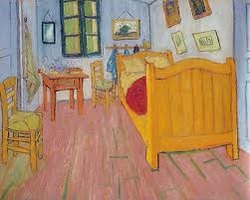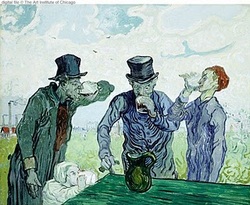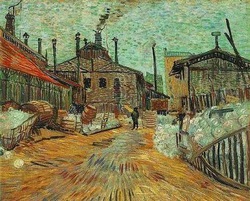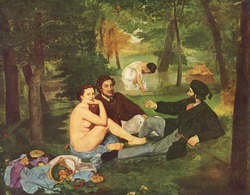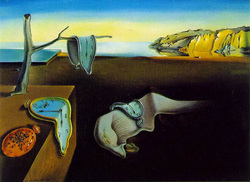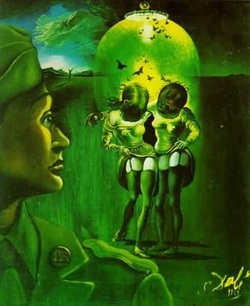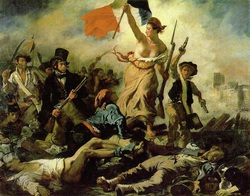Description

Tutorial-- Description: http://www.youtube.com/watch?v=2JJegHNy8vs
13 October: Typed Copy of Comparison Due; Description Notes/5 question outline F 15 October: 5 question outline due; M 18 October: Completed Rough Draft Due; Grammar Take Home Test W 20 October: Final Typed Copy of Description Due, Analysis Notes; F 22 October: Grammar Take Home Test Due
Description Essay Assignment Description & Interpretation: Reading Art
Skills: Describing visual image using all 5 senses; interpreting the significance of a visual image; appreciation of the visual arts; the ability to convey in words a "reading" of an image.
Directions: Choose 1 painting from the list, and vividly describe it using your senses. Incorporate the art terminology you learned. Finally, provide a basic interpretation of the image. You will want to ask yourself what the "theme" of the painting is-- what is the "message" that the painting sends. The essay should be 5 paragraphs, approximately 5 sentences per paragraph (no less), written in concise but precise complex sentences; it should also be double-spaced and in 12 point font. Follow MLA style guidelines. Include a "Work Cited" page that lists ONLY the painting-- you will NOT consult outside sources -- no interpretation or background information on the painting or the author-- for this essay. You can find out how to cite a painting in your handbook. Base your interpretation entirely on the work itself-- this should be all your own ideas and words. Always include a unique title (not the title of the painting), and always mention the name of the painting and the artist in the introduction (but that information should not take up a sentence all by itself). Titles of paintings are always underlined or italicized.
Your thesis statement should be near the beginning of the first paragraph and should clearly state the artist, title, and theme / message of the painting. It is not unusual to have a "thesis paragraph" rather than nailing it down in just one sentence (in a descriptive essay).
Each topic sentence should introduce the discussion of a particular element of the painting (such as brushstroke, imagery, color, etc.) in relation to that theme / message. Topic statements should be generalized and give an overview of the paragraph. All supporting details should be explained clearly and connected back to the topic. Your description should be vivid.
Questions to Ask about Photographs or Paintings-- These questions will serve as your outline for this essay. Answer the questions about your painting. To help you write the essay, you should consider the questions below.
Do not try to describe everything in the painting. Focus on describing the important parts, the parts that help reveal the meaning according to your interpretation.
Your Analysis
You will need to go beyond just describing the painting. You also need to analyze it. Analysis is "a way of thinking, arriving at conclusions, and discovering meaning". Your description of the painting should lead you to discover its meaning.
Important! For each descriptive detail you consider including in your essay, you should ask yourself a simple question: "So what?" Why is what you are describing important? What does it mean? In your essay, you should avoid including descriptive details if you do not explain their importance.
While there may be no "right" or "wrong" interpretation of the painting you write about, there is quite a difference between a weak and a strong interpretation. Your analysis will be strong, and thus convincing to readers, if you draw logical conclusions from the details, making clear connections between your interpretation and the specific details of the painting, and if you organize and explain your ideas clearly and logically.
You do not have to be an expert on art to write a strong essay for this assignment! . Work on demonstrating skills essential to all effective writers: the ability to observe, describe, analyze, think, and present ideas well.
[The above was taken from an assignment by Professor Randy Rambo]
Art Terminology:
Brushstroke Color Foreground/Background Line Perspective Motif Structure Style Symbol
Model: Observe Connect Signify Interpret
To begin: Make Observations [Examples are based on the painting "Starry Night"]
Example: Color- Intense; Brushstroke- Thick; Elements: Stars (have circles of light around them); There's also a white disk (sun?); Cypress Tree dominates the left foreground; There's a village below with a chapel.
Then Make Connections
Example: The bright sky above is in contrast to the dark, quiet village below; the tree and stars look almost like they are burning; the scale of the village is quite small in proportion to the sky and stars (natural elements)
Then Make Inferences
Example: The vibrant colors (blue, yellow, white) seem to suggest that nature is vibrant-- it is alive, flowing, and all-encompassing. The thick brushstrokes give the elements of the painting depth-- nature comes alive and almost pops off of the canvas. The scale is very striking; the fact that the natural elements (sky, tree, etc.) are so much bigger and of more focus than the man-made elements (village, church, etc.) seems to suggest that nature is overwhelming... that it is in control of "us".
Finally, interpret!
Nature is the ultimate power. Because it is all-encompassing and to some extent controlling, it contains a spiritual aspect. Perhaps nature is even more "spiritual" than churches or "religion" because we do not have to have faith-- we experience it (in all its glorious power) everyday throughout our lives.
Follow this model for composing each body paragraph:
TopicSentence/Example/Explanation/Connection/Interpretation/Transition
*Each topic sentence should contain a KEY word from your art vocabulary, such as color, brushstroke, scale, motif, symbol, etc.*
SAMPLE ESSAY: [Don't forget to double-space]
Student’s Name
English 1301, Fall 2008
Essay #2: Description/Interpretation
The Method in the Madness: Van Gogh’s “Uber Nature”
The painting Starry Night by Vincent Van Gogh seems rooted in chaos; however, upon closer examination, there appears to be a method in the seeming madness. The subject of the work is undoubtedly nature, more specifically, the way that the elements of Earth, Air, and particularly Fire and Water, come together to assert undeniable power. The painting alludes to the spiritual aspect of nature. The colors, brushstrokes, and scale of the work reveal a parallel between a village and its outer surroundings. The way that each aspect of the painting work together tells a deeper story about man’s place in the natural world.
The colors in the painting evoke the imagery of nature in its most vibrant forms. Blue dominates the painting and suggests a symbol of movement; the clouds and hills flow across the canvas like waves making their way to shore. The moon and stars are illuminated by a vivid yellow, a color that conjures up imagery of flames, as they burn brightly in the night sky. The yellow is repeated as the backdrop to the cypress tree in the foreground, whose shape also represents a flame. The white, whispy swirls around the sun and in the sky reflect the imagery of being “light as air”; the purity of the whiteness is paralleled with the specks of brown in the hills and the bush. The brown is representative of dirt, or earth. The colors, which evoke the natural elements, are repeated in the scene of the village below.
The brushstrokes in the painting are all very thick and give the painting an unparalleled level of intensity; it is as if the scene wants to pop off of its canvas. It is as if Van Gogh piled on the paint to ensure that we would take notice of his message. The quick and swirling brushstrokes evoke the imagery of movement. As the night goes on, the scene in the sky will likely change, but we are left with this single awe-inspiring image of nature in flux. The lines seem to go in random directions, but they are also small and disconnected. Interestingly, the fact that the whole painting is made up the same lines and brushstrokes suggests unity, perhaps the unification of natural elements, amidst this chaos.
The large scale of the sky at the top of the painting is in direct contrast to the miniscule representation of the village below. The large Cypress tree in the foreground seems to interrupt the sky, which appears to be the dominant subject of the painting. The tree ascends into the sky, not unlike its mirror image counterpart, the chapel in the little village, whose steeple also points upward. The scale of the tree and sky, the natural elements in the paintings, overwhelm the little man-made village. This suggests that while we have built towns and villages into the landscape, the natural elements still dominate overall.
Starry Night conveys imagery of chaos and power. While nature can seem chaotic and its power can be overwhelming, it is only “natural” that it be this way. Nature controls our lives; it dictates, to some extent, when we eat, sleep, work, etc. The sometimes harsh presentation of the elements can keep us indoors and halt our daily routines. It is in this power of nature that we find a spiritual quality, not unlike that of “church” or “god”, but perhaps even moreso because we can see it, hear it, feel it, smell it, rather that only imagine it. We don’t need faith to believe in the power of nature- the proof surrounds us everyday.
Works Cited
Van Gogh, Vincent. Starry Night. 1889. The Museum of Modern
Art , New York .
Below are your subject choices for this assignment. Choose the one that speaks to you-- the one that delivers a message to you.
Remember that the "core" of this essay is some sort of "tension"-- the "light" and the "dark", the "cold" and the "warmth", the "big" and the "small"-- whatever the polarity is, it must pull at its opposite side; the meaning is found in the middle of the two sides being pulled. In other words Aspect A of the painting is working against Aspect B of the painting, and the significance of that is ?. You fill in the blanks.
WARNING: Yes, I am fully aware that there are painting analyses available on the internet! If you can find them, then trust me, so can I! You are not to consult ANY outside sources to help you understand, explain, or analyze this painting. Every idea that you write about should be YOUR OWN. If I catch anyone using an idea, much less copying, from an outside source, then you will get an automatic "0" on this paper-- period. Why the big, red warning? Because I rarely go a semester without catching plagiarism-- don't do it. Resist the temptation. Finding out what other people said about this painting or seeking out the history of the painting is not acceptable for this assignment. Do not include biography or research into your essay-- just decide what you think the painting means and discuss how/why you came to that conclusion using descriptive language. YOU CAN DO THIS.
13 October: Typed Copy of Comparison Due; Description Notes/5 question outline F 15 October: 5 question outline due; M 18 October: Completed Rough Draft Due; Grammar Take Home Test W 20 October: Final Typed Copy of Description Due, Analysis Notes; F 22 October: Grammar Take Home Test Due
Description Essay Assignment Description & Interpretation: Reading Art
Skills: Describing visual image using all 5 senses; interpreting the significance of a visual image; appreciation of the visual arts; the ability to convey in words a "reading" of an image.
Directions: Choose 1 painting from the list, and vividly describe it using your senses. Incorporate the art terminology you learned. Finally, provide a basic interpretation of the image. You will want to ask yourself what the "theme" of the painting is-- what is the "message" that the painting sends. The essay should be 5 paragraphs, approximately 5 sentences per paragraph (no less), written in concise but precise complex sentences; it should also be double-spaced and in 12 point font. Follow MLA style guidelines. Include a "Work Cited" page that lists ONLY the painting-- you will NOT consult outside sources -- no interpretation or background information on the painting or the author-- for this essay. You can find out how to cite a painting in your handbook. Base your interpretation entirely on the work itself-- this should be all your own ideas and words. Always include a unique title (not the title of the painting), and always mention the name of the painting and the artist in the introduction (but that information should not take up a sentence all by itself). Titles of paintings are always underlined or italicized.
Your thesis statement should be near the beginning of the first paragraph and should clearly state the artist, title, and theme / message of the painting. It is not unusual to have a "thesis paragraph" rather than nailing it down in just one sentence (in a descriptive essay).
Each topic sentence should introduce the discussion of a particular element of the painting (such as brushstroke, imagery, color, etc.) in relation to that theme / message. Topic statements should be generalized and give an overview of the paragraph. All supporting details should be explained clearly and connected back to the topic. Your description should be vivid.
Questions to Ask about Photographs or Paintings-- These questions will serve as your outline for this essay. Answer the questions about your painting. To help you write the essay, you should consider the questions below.
- How would you describe the painting to someone who has not seen it? What details are more prominent than others? Why? [LIST HERE]
- How do you respond to the painting? What emotions does it stimulate? What specific details of the painting stimulate these feelings? [List the predominate emotion that the painting stimulates then give at least 3 supporting details that lead you to observe that emotion]
- What seems to be the point of the painting? What meaning does it convey? [This is the "social commentary" or message-- try to sum it up in a complete idea here]
- How does the painting convey its meaning? [Brushstroke, color, line, etc.... list 3 ways at least AND give examples of each way.]
5. How do the details work together to establish its meaning? How are the different details of the photograph or painting related? Can you compare or contrast different elements (ex. the light and the dark, the big and the small, the realism and the fantasy, etc.) of the painting? [Make at least 3 solid connections here]
Do not try to describe everything in the painting. Focus on describing the important parts, the parts that help reveal the meaning according to your interpretation.
Your Analysis
You will need to go beyond just describing the painting. You also need to analyze it. Analysis is "a way of thinking, arriving at conclusions, and discovering meaning". Your description of the painting should lead you to discover its meaning.
Important! For each descriptive detail you consider including in your essay, you should ask yourself a simple question: "So what?" Why is what you are describing important? What does it mean? In your essay, you should avoid including descriptive details if you do not explain their importance.
While there may be no "right" or "wrong" interpretation of the painting you write about, there is quite a difference between a weak and a strong interpretation. Your analysis will be strong, and thus convincing to readers, if you draw logical conclusions from the details, making clear connections between your interpretation and the specific details of the painting, and if you organize and explain your ideas clearly and logically.
You do not have to be an expert on art to write a strong essay for this assignment! . Work on demonstrating skills essential to all effective writers: the ability to observe, describe, analyze, think, and present ideas well.
[The above was taken from an assignment by Professor Randy Rambo]
Art Terminology:
Brushstroke Color Foreground/Background Line Perspective Motif Structure Style Symbol
Model: Observe Connect Signify Interpret
To begin: Make Observations [Examples are based on the painting "Starry Night"]
Example: Color- Intense; Brushstroke- Thick; Elements: Stars (have circles of light around them); There's also a white disk (sun?); Cypress Tree dominates the left foreground; There's a village below with a chapel.
Then Make Connections
Example: The bright sky above is in contrast to the dark, quiet village below; the tree and stars look almost like they are burning; the scale of the village is quite small in proportion to the sky and stars (natural elements)
Then Make Inferences
Example: The vibrant colors (blue, yellow, white) seem to suggest that nature is vibrant-- it is alive, flowing, and all-encompassing. The thick brushstrokes give the elements of the painting depth-- nature comes alive and almost pops off of the canvas. The scale is very striking; the fact that the natural elements (sky, tree, etc.) are so much bigger and of more focus than the man-made elements (village, church, etc.) seems to suggest that nature is overwhelming... that it is in control of "us".
Finally, interpret!
Nature is the ultimate power. Because it is all-encompassing and to some extent controlling, it contains a spiritual aspect. Perhaps nature is even more "spiritual" than churches or "religion" because we do not have to have faith-- we experience it (in all its glorious power) everyday throughout our lives.
Follow this model for composing each body paragraph:
TopicSentence/Example/Explanation/Connection/Interpretation/Transition
*Each topic sentence should contain a KEY word from your art vocabulary, such as color, brushstroke, scale, motif, symbol, etc.*
SAMPLE ESSAY: [Don't forget to double-space]
Student’s Name
English 1301, Fall 2008
Essay #2: Description/Interpretation
The Method in the Madness: Van Gogh’s “Uber Nature”
The painting Starry Night by Vincent Van Gogh seems rooted in chaos; however, upon closer examination, there appears to be a method in the seeming madness. The subject of the work is undoubtedly nature, more specifically, the way that the elements of Earth, Air, and particularly Fire and Water, come together to assert undeniable power. The painting alludes to the spiritual aspect of nature. The colors, brushstrokes, and scale of the work reveal a parallel between a village and its outer surroundings. The way that each aspect of the painting work together tells a deeper story about man’s place in the natural world.
The colors in the painting evoke the imagery of nature in its most vibrant forms. Blue dominates the painting and suggests a symbol of movement; the clouds and hills flow across the canvas like waves making their way to shore. The moon and stars are illuminated by a vivid yellow, a color that conjures up imagery of flames, as they burn brightly in the night sky. The yellow is repeated as the backdrop to the cypress tree in the foreground, whose shape also represents a flame. The white, whispy swirls around the sun and in the sky reflect the imagery of being “light as air”; the purity of the whiteness is paralleled with the specks of brown in the hills and the bush. The brown is representative of dirt, or earth. The colors, which evoke the natural elements, are repeated in the scene of the village below.
The brushstrokes in the painting are all very thick and give the painting an unparalleled level of intensity; it is as if the scene wants to pop off of its canvas. It is as if Van Gogh piled on the paint to ensure that we would take notice of his message. The quick and swirling brushstrokes evoke the imagery of movement. As the night goes on, the scene in the sky will likely change, but we are left with this single awe-inspiring image of nature in flux. The lines seem to go in random directions, but they are also small and disconnected. Interestingly, the fact that the whole painting is made up the same lines and brushstrokes suggests unity, perhaps the unification of natural elements, amidst this chaos.
The large scale of the sky at the top of the painting is in direct contrast to the miniscule representation of the village below. The large Cypress tree in the foreground seems to interrupt the sky, which appears to be the dominant subject of the painting. The tree ascends into the sky, not unlike its mirror image counterpart, the chapel in the little village, whose steeple also points upward. The scale of the tree and sky, the natural elements in the paintings, overwhelm the little man-made village. This suggests that while we have built towns and villages into the landscape, the natural elements still dominate overall.
Starry Night conveys imagery of chaos and power. While nature can seem chaotic and its power can be overwhelming, it is only “natural” that it be this way. Nature controls our lives; it dictates, to some extent, when we eat, sleep, work, etc. The sometimes harsh presentation of the elements can keep us indoors and halt our daily routines. It is in this power of nature that we find a spiritual quality, not unlike that of “church” or “god”, but perhaps even moreso because we can see it, hear it, feel it, smell it, rather that only imagine it. We don’t need faith to believe in the power of nature- the proof surrounds us everyday.
Works Cited
Van Gogh, Vincent. Starry Night. 1889. The Museum of Modern
Art , New York .
Below are your subject choices for this assignment. Choose the one that speaks to you-- the one that delivers a message to you.
Remember that the "core" of this essay is some sort of "tension"-- the "light" and the "dark", the "cold" and the "warmth", the "big" and the "small"-- whatever the polarity is, it must pull at its opposite side; the meaning is found in the middle of the two sides being pulled. In other words Aspect A of the painting is working against Aspect B of the painting, and the significance of that is ?. You fill in the blanks.
WARNING: Yes, I am fully aware that there are painting analyses available on the internet! If you can find them, then trust me, so can I! You are not to consult ANY outside sources to help you understand, explain, or analyze this painting. Every idea that you write about should be YOUR OWN. If I catch anyone using an idea, much less copying, from an outside source, then you will get an automatic "0" on this paper-- period. Why the big, red warning? Because I rarely go a semester without catching plagiarism-- don't do it. Resist the temptation. Finding out what other people said about this painting or seeking out the history of the painting is not acceptable for this assignment. Do not include biography or research into your essay-- just decide what you think the painting means and discuss how/why you came to that conclusion using descriptive language. YOU CAN DO THIS.
Descriptive Words to use in a Formal Critique of Art
ELEMENTS OF
ART
Line
blurred
broken
controlled
curved
diagonal
freehand
horizontal
interrupted
geometric
meandering
ruled
short
straight
thick
thin
vertical
wide
reversed
Texture
actual
bumpy
corrugated
flat
furry
gooey
leathery
prickly
rough
sandy
shiny
simulated
smooth
soft
sticky
tacky
velvet
wet
Colors
brash
bright
calm
clear
cool
dull
exciting
garish
grayed
multicolored
muted
pale
polychromed
primary
saccharine
secondary
subdued
sweet
warm
Shape/Form
amorphous
biomorphic
closed
distorted
flat
free-form
full of spaces
geometric
heavy
light
linear
massive
nebulous
open
organic
Value
dark
light
medium
Space
ambiguous
deep
flat
negative/positive
open
shallow
Principles of Art
balance
contrast
emphasis
harmony
pattern
repetition
rhythm
unity
variety
Themes in Art
adoration
children
circus
cityscape
earth, air, fire, water
farming festivals
gardens
grief
history
hunting
landscape
love
music
mythology
of historic occasions
portraiture
processions
religion
seascape
storytelling
theater
war
STYLE OR
PERIOD
abstract
classical
genre
historical
literary
naïve
narrative
nonobjective
primitive
realistic
romantic
Renaissance
Pop
Op
Modern
Abstract Expression
MEDIA (MATERIALS)
Two-Dimensional
chalk
colored pencil
conte
egg tempera
found materials
gouache
ink
oil
pastel
pencil
photograph
print
tempera
vine charcoal
watercolor
Three-Dimensional
bronze
clay
fibers
found materials
marble
metal
mixed media
papier-mâché
plaster
stone
wood
TECHNIQUE
architecture
batik
carving
ceramics
collage
crafts
glassblowing
jewelry making
metalwork
modeling
mosaics
painting
photography
printmaking
repousse
sculpture
weaving
ELEMENTS OF
ART
Line
blurred
broken
controlled
curved
diagonal
freehand
horizontal
interrupted
geometric
meandering
ruled
short
straight
thick
thin
vertical
wide
reversed
Texture
actual
bumpy
corrugated
flat
furry
gooey
leathery
prickly
rough
sandy
shiny
simulated
smooth
soft
sticky
tacky
velvet
wet
Colors
brash
bright
calm
clear
cool
dull
exciting
garish
grayed
multicolored
muted
pale
polychromed
primary
saccharine
secondary
subdued
sweet
warm
Shape/Form
amorphous
biomorphic
closed
distorted
flat
free-form
full of spaces
geometric
heavy
light
linear
massive
nebulous
open
organic
Value
dark
light
medium
Space
ambiguous
deep
flat
negative/positive
open
shallow
Principles of Art
balance
contrast
emphasis
harmony
pattern
repetition
rhythm
unity
variety
Themes in Art
adoration
children
circus
cityscape
earth, air, fire, water
farming festivals
gardens
grief
history
hunting
landscape
love
music
mythology
of historic occasions
portraiture
processions
religion
seascape
storytelling
theater
war
STYLE OR
PERIOD
abstract
classical
genre
historical
literary
naïve
narrative
nonobjective
primitive
realistic
romantic
Renaissance
Pop
Op
Modern
Abstract Expression
MEDIA (MATERIALS)
Two-Dimensional
chalk
colored pencil
conte
egg tempera
found materials
gouache
ink
oil
pastel
pencil
photograph
tempera
vine charcoal
watercolor
Three-Dimensional
bronze
clay
fibers
found materials
marble
metal
mixed media
papier-mâché
plaster
stone
wood
TECHNIQUE
architecture
batik
carving
ceramics
collage
crafts
glassblowing
jewelry making
metalwork
modeling
mosaics
painting
photography
printmaking
repousse
sculpture
weaving
